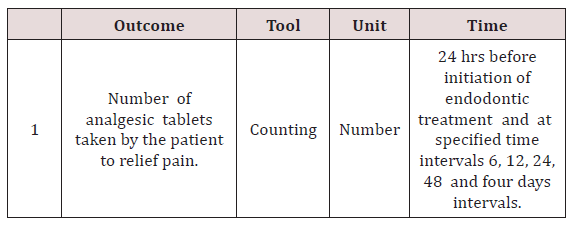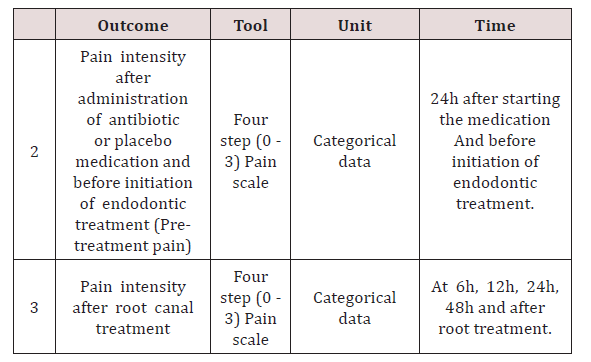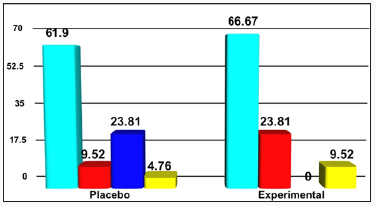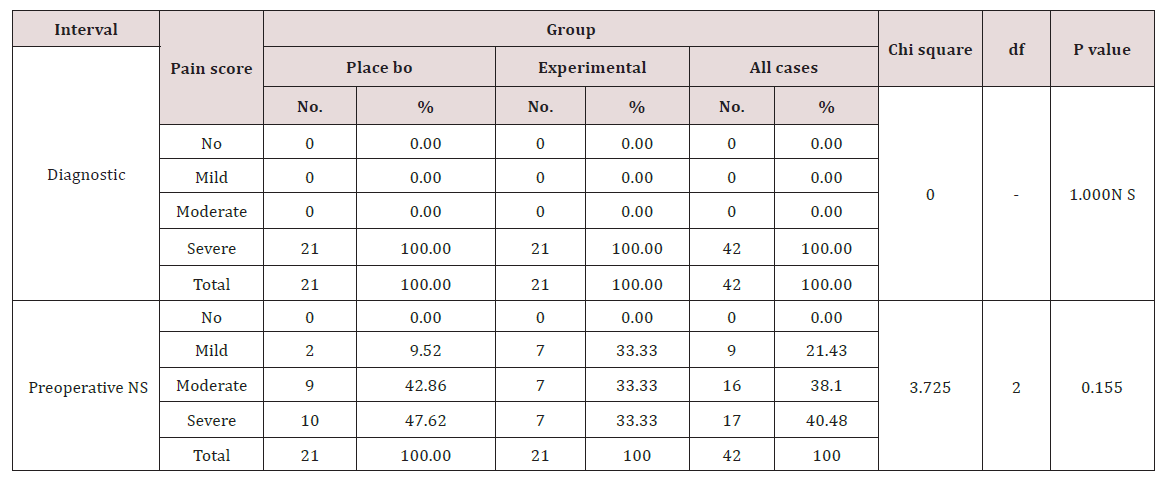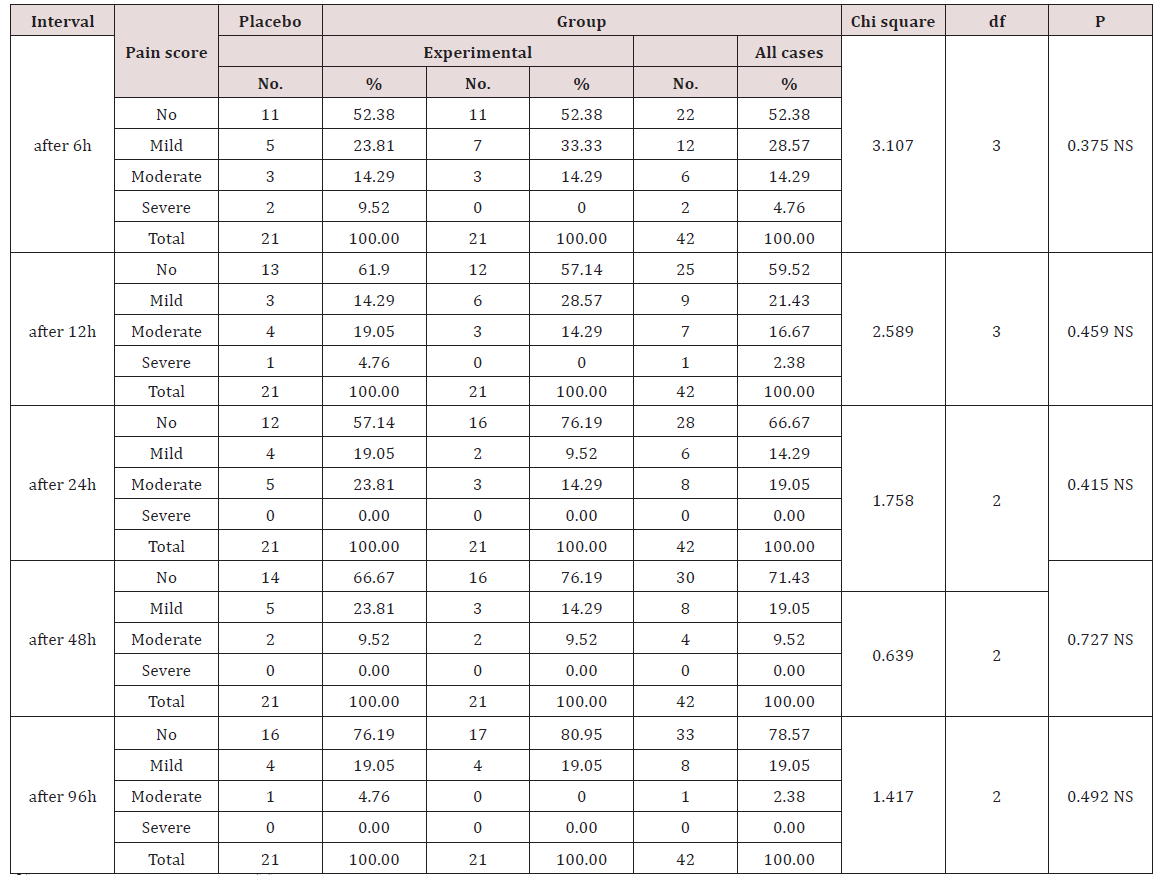
Lupine Publishers Group
Lupine Publishers
Menu
ISSN: 2637-4692
Research Article(ISSN: 2637-4692) 
Effect of Amoxicillin with Clavulanic Acid Antibiotic Premedication on Pre-Treatment and Post-Endodontic Pain in Teeth with Irreversible Pulpitis: A Randomized. Controlled Trial Volume 2 - Issue 1
Mohamed M Abielhassan1*, khaled M Ezzat2 and Geraldine M Ahmed3
- 1Department of oral and dental medicine, Cairo University, Egypt
- 2Professor of Endodontics, Faculty of oral and dental medicine, Cairo University, Egypt
- 3Assistant professor of Endodontics, Faculty of oral and dental medicine, Cairo University.
Received: April 04, 2018; Published: April 19, 2018
Corresponding author:Mohamed M Abielhassan, Assisstant Lecturer, Faculty of oral and dental medicine, Cairo University, Egypt
DOI: 10.32474/MADOHC.2018.02.000127
Abstract
The purpose of this randomized, double-blind, controlled study was to assess the effect of antibiotic premedication on pre treatment and post opertive pain after endodontic treatment. Forty two patients with symptomatic irreversible pulpitis were randomized and allocated to experimental and placebo groups where the experimental group received the antibiotic premedication. Degree of pain was measured by the number of analgesics needed in addition to a four step pain scale before initiation of endodontic treatment and at time intervals of 6, 12, 24, 48 and 96 hours. We found that no statistical significant difference was detected at the pretreatment time interval. Statistical significant difference was groups after 24 hours of endodontic treatment where the experimental group reported less degree of post operative pain than the placebo group. No statistical significance difference detected at other time intervals. we concluded that antibiotic premedication could be prescribed to lessen the degree of post operative. pain after endodontic treatment
Keywords: Amoxicillin with Clavulanic Acid Antibiotic; Antibiotics premedicaton; Pre-Treatment pain; Post-Endodontic Pain; Irreversible Pulpitis; Single visit endodontics
Introduction
Post-operative pain is defined as pain of any degree that occurs after initiation of RCT. One of the most important challenges during endodontic treatment is to control pain during and after root canal treatment. The prevalence of pain after root canal treatment has been reported to be 3% -58% of patients [1]. The development of postoperative pain after RCT is usually due to acute inflammatory response in the peri-radicular tissues. It commences within few hours or days after endodontic treatment. Patients might consider postoperative pain as a benchmark against which the clinician’s skills are measured. It might undermine patients’ confidence in their dentists or patient satisfaction with the treatment. Clinical guidelines recommend that the first-line treatment for teeth with acute irreversible pulpitits and symptomatic apical periodontitis should be removal of the source of inflammation or infection by local operative measures. It also recommends that systemic antibiotics are currently only recommended for situations where there is evidence of spreading infection (cellulitis, lymph node involvement, diffuse swelling) or systemic involvement (fever, malaise). Despite this, there is evidence that dentists continue to prescribe antibiotics for these conditions. There is concern that this could contribute to the development of antibiotic-resistant bacterial colonies both within the individual and within the community as a whole [2]. The important role of bacteria has been established in different studies that concluded that the pathogenesis of pulp and periapical diseases is directly related to bacteria. In absence of bacteria there is no inflammatory response and damaged tissues can heal. The reduction of inflammatory response means directly reduction of pain [3].
A search of the Pub Med and Cochrane databases for evidencebased investigations on the effect of antibiotic premedication on postoperative pain after endodontic treatment revealed a lack of investigations with a high level of evidence. A published systematic review in the Cochrane Library 2013, issue 12 “ Antibiotic use for irreversible pulpitis” stated that there is insufficient evidence to determine whether antibiotics reduce pain compared to not having antibiotics. The results of this review confirmed the necessity for further larger sample and different methodological trials that can provide additional evidence as to whether antibiotics, prescribed in the preoperative phase, can affect treatment outcomes for irreversible pulpitis [4].
Material and Methods
Forty-two adult patients diagnosed with symptomatic irreversible pulpitis participated in this study. All patients were in good health as determined by a written health history and oral questioning. Subjects were not taking antibiotics nor had they received them within 30 days before participation in the study. The study was approved by the Ethics committee, Faculty of Oral and Dental Medicine, Cairo University, and written consent was obtained from each patient.
The participants were randomly divided into 2 groups: group A and group B (n=21).Group A (intervention) received Augmentin 1g (amoxicillin with clavulanic acid) in addition to Brufen 200mg as an analgesic to be used in case of feeling pain after endodontic treatment and group B (control) received placebo tablets in addition to Brufen 200mg to be used as an analgesic in case of feeling pain after endodontic treatment.
Endodontic treatment procedure
The endodontic treatment was performed in a single visit. Four step pain scale was given to each patient to rate the level of preoperative pain. The patient received an envelope containing either the antibiotic or placebo tablet prescribed to be taken every 12 hours for five days. Patients were rescheduled 24 hours later to rate the pain level (pretreatment pain).
Endodontic treatment was performed as follows
system): the speed of the electric motor was adjusted to be 250- 300 rpm and the torque of each file was adjusted according to the manufacturer instructions. Irrigation was made between each file using 2.5% sodium hypochlorite (NaOCl) using disposable plastic syringe and ethylene diamine tetra-acetic acid (EDTA) cream as lubricant was used. 17% EDTA was used as final irrigation. Master cone of guttapercha corresponded to the size of file used and radiograph was taken to ensure the correct working length. Canals were then dried with paper points and obturated with guttapercha and ADSEAL resin sealer, then spreader was selected to provide auxiliary cones using cold lateral compaction technique. Access cavity was then sealed with temporary filling. Postoperative radiograph was taken after complete root canal treatment.
Patient was given the four step pain scale to measure the degree of pain at 6, 12, 24, 48 hours and four days after endodontic treatment while the prescription of antibiotic or placebo tablets are continued. Patients received a prescription including Brufen 200mg to be taken on demand in case of feeling pain. Patients were also instructed to record time and date of each tablet in a schedule on the paper of the four step pain scale. Patients were rescheduled four days after endodontic treatment for delivering the pain scale and referral to final restoration.
Results
The fourty two patients were divided equally on both the placebo and experimental groups where each group contained twenty one patients which were statistically analyzed for the selected outcomes to assess effect of group on the selected outcomes, also other data as effect of age, sex, tooth position and numbers of root canals were also statistically analyzed.
The effect of amoxicillin with clavulanic acid antibiotic premedication on number of needed analgesic by the patients after administration of the antibiotic or the placebo tablets and before initiation of endodontic treatment (pretreatment pain) was assessed. The results showed no statistically significant difference detected between both groups. The results are illustrated in the following Table 1.
Table 1: Effect of group on prevalence of number of analgesic tablets at pre-treatment time interval.

df = Degrees of freedom P = Probability level for the effect of group (Chi square test).
NS= Non significant difference *= Significant defference
The effect of Amoxicillin with clavulanic acid Antibiotic premedication on number of needed analgesic tablets by the patients was assessed at the specified time intervals as a reflection of the degree of pain felt by the patients allocated in both groups. The results were statistically analyzed and statistically significant difference was detected at the 24 hrs time interval where the number of analgesic tablets needed by the experimental groups was less than that needed by the placebo group where P=0.035. Other time intervals didn’t show detected statistically significant difference. The statistical results were illustrated in the following Table 2.
Table 2: Effect of group on prevalence of number of analgesic tablets at post operative different intervals.
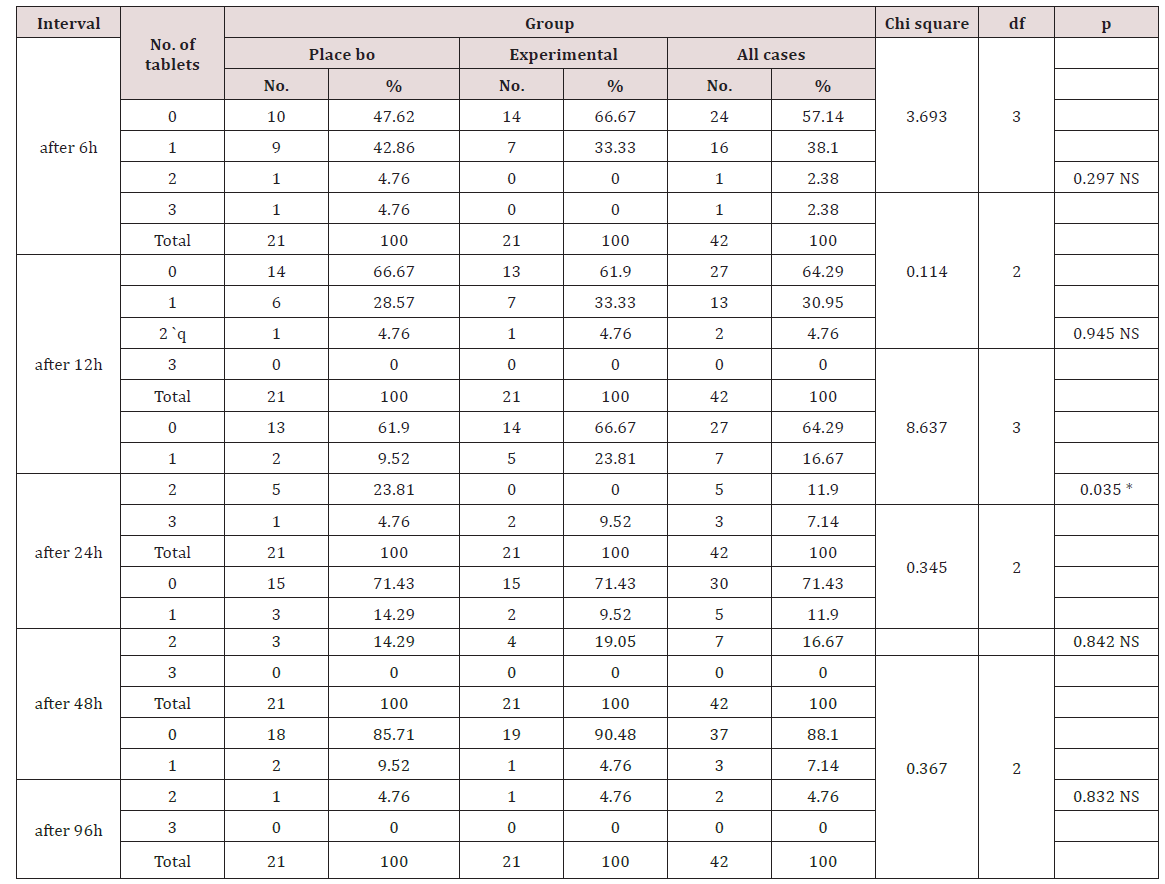
df = Degrees of freedom P = Probability level for the effect of group (Chi square test).
NS= Non significant difference *= Significant defference
The statistically significant prevalence of the number of analgesic tablets between two groups at 24 hrs time interval was illustrated in the following histogram. The histogram shows that percentage of patients who needed two analgesic tablets at the 24 hours time interval was 23.81% in placebo group while in the Experimental group 0% of patients needed two analgesic tablets to alleviate post operative pain. The results are illustrated in the following histogram Figure 1.
The effect of amoxicillin with clavulanic acid antibiotic premedication on pretreatment pain after administration of antibiotic and before initiation of endodontic treatment (Pretreatment pain) was assessed for patients using a four step pain scale (No pain, Mild , Moderate, Severe). The results showed no statistically significant difference detected between both groups. The results are illustrated in the following Table 3.
df = Degrees of freedom
P = Probability level for the effect of group (Chi square test).
NS = Insignificant p>0.05
The degree of postoperative pain was assessed for patients using a four step pain scale (No pain, Mild , Moderate, Severe) at specified different time intervals. The results were statistically analyzed and showed no statistically significant difference pain scoring between both groups at any time interval. The results were illustrated in the following Table 4.
df = Degrees of freedom
P = Probability level for the effect of group (Chi square test).
NS = Insignificant p>0.05
Discussion
Alleviating pain is of the upmost importance when treating dental patients as it is prevalent and has far-reaching implications for both patients and the clinician. The major cause of pain is thought to be the release of inflammatory mediators that activates sensory nociceptors surrounding the tooth. The resultant stimulation of both central and peripheral mechanisms is referred to as hypergesia and defined as increase in magnitude of painful stimuli [5]. Given that the mechanisms involved are occurring at the periphery, an anti-inflammatory agent should be used to control pain.
This study was designed as randomized, double blinded clinical trial on 42 participants with symptomatic irreversible pulpitis. The three elements of randomization (sequence generation, allocation concealment and implementation) ensure that all participants have the same chance to be enrolled in any of the study groups [6].This design is the way to assure balance of the unknown prognostic factors in the participants between the two groups eliminating what is known as selection or allocation bias [7].
In this study, the participants were blinded to the premedication used that reduces the performance bias, also the outcome assessor was blinded that prevented the detection bias which might affect the outcomes [7]. The methodological steps of this study was selected to produce the least postoperative pain to patients in order to precisely test the effect of the antibiotic prescription on degree of post operative pain.
Single visit endodontic line of treatment was selected as the final diagnosis of enrolled patients was acute irreversible pulpitis. There is no effect on degree of post operative pain when performing root canal treatment in single visit than multiple visits. Several studies concluded than there is no difference on degree or incidence of postoperative pain in single visit than multiple visits [8,9]. This in agreement with a systematic review of randomized controlled trials that concluded that incidence of post operative pain is the same when performing root canal treatment in single or multiple visits One-visit endodontic therapy was no more uncomfortable and as equally successful as multiple-visit therapy, no difference in the incidence of post treatment complications between single and multiple appointments [10].
Single visit endodontic treatment was chosen as the most important advantage is the prevention of root canal contamination and/or bacterial regrowth that can occur when the treatment is prolonged over an extended period. Studies on long-term success also favor single-visit endodontics in non-infected teeth [11]. Also it was found that one-appointment endodontic postoperative sequelae and healing did not differ significantly when compared to two-visit endodontics [12]. Moreover, a single-visit approach might also prevent the occurrence of pain resulting from reinfection of the canals as a consequence of bacterial ingress from a leaky temporary restoration. While, multiple-visit technique involves the placement of a temporary seal Recontamination of the root canals or secondary microbial invasion might be another reason leading to the higher post-obturation pain in mult Rotary instrumentation technique was selected for mechanical preparation of root canals owing to its privilege in producing less incidence of post operative pain than manual or hybrid techniques [13]. The engine-driven techniques extruded smaller amounts of debris and irrigants, presumably due to the rotatory motion, which tended to direct debris toward the orifice, avoiding its compaction in the root canal [14,15]. Decreased apical extrusion of debris had strong implications on decreased incidence of postoperative inflammation and pain.
The rational use of antibiotics is based upon three variables: a defined indication, the appropriateness of the antibiotic and the adverse effects associated with the drug. The first factor is the most contentious because there is a paucity of scientific evidence to support the use of antibiotics in clinical practice. Antibiotics are prescribed in endodontic practice for either therapeutic or prophylactic purposes. The principles underlying the therapeutic use of antibiotics are fundamentally different from those applied to chemoprophylaxis [16,17].
The protocol for administration of the antibiotic was based on previous studies that used amoxicillin as premedication in relation to pain either pretreatment or post operative pain. Selection of the 24 hours interval prior to initiation of root canal treatment was selected in agreement with Nagle et al [18] who performed a study to determine the effect of penicillin on pain in untreated teeth diagnosed with irreversible pulpitis without performing root canal treatment. The study concluded that the administration of penicillin did not significantly reduce pain, Meanwhile patients also recorded a pain decrease after the first day of antibiotic administration followed by nearly similar degree of pain for the rest of the seven days. The results of that study give a relative indication that performing root canal treatment is necessary for total relief of pain in patients with acute irreversible pulpitis so the regimen for treatment of patients was selected so as to test the effect of the antibiotic as premedication for 24 hours followed by root canal treatment to alleviate pain then comparison of degree of post operative pain between both groups to also test the effect of the antibiotic.
There has been no statistically significant difference detected between the experimental and control groups regarding the incidence of pretreatment pain before initiation of endodontic treatment. Meanwhile it should be reported that out of 21 patients allocated in the experimental group 7 patients reported that they had marked decrease of pain after prescription of the antibiotic. On the other hand out of 21 patients allocated in the control group 3 patients also reported decrease in degree of pain after initiation of placebo tablets. This concludes that antibiotic might have had an effect on degree of pretreatment pain that was insufficient to be statistically significant and dictates performing further studies with different methodological steps and/or larger sample.
The results of this study showed statistically significant difference in number of analgesic tablets consumed by the patients at the interval of 24 hours after endodontic treatment. The percentage of patients who needed 2 analgesic tablets in experimental group was 0% where in the control group the percentage was 23.81%, which revealed that the experimental group had less degree of pain than control group. These results coincided with the recent publication of the randomized controlled trial of similar methodological steps and outcomes detected by Alsomadi L and Al Habahbeh R [19] where they concluded that antibiotic premedication (amoxicillin and clavulanic acid) resulted in less number of analgesic tablets consumed in experimental group 24, 32, 40, and 48 hours post-treatment with less pain recorded on pain scale used. This concludes that amoxicillin with clavulanic acid premedication had an impact on degree of postoperative pain.
On the contrary other studies stated that the rapid increase in emergence of antibiotic resistant bacteria and the global trend to refrain the overuse of antibiotics to avoid emergence of antibiotic resistant strains of bacteria that complicates the treatment of various bacterial induced diseases. In May 2016 the first case recorded in United States of a patient with an infection resistant to a last-resort antibiotic, and expressed grave concern that the superbug could pose serious danger for routine infections if it spreads. This arouses the fears of starting the post antibiotic era where some strains become resistant to all antibiotics. Thus all global trends are directed towards prohibition of overuse and useless prescribing of antibiotics [20].
Studies that concluded lack of need of prescription of antibiotics was basically depending on lack of sufficient evidence and studies that prove that antibiotics prescription would result in lesser degree of postoperative pain or even pain before initiation of endodontic treatment. Systematic reviews should the need of further studies and evidence to correlate the use of antibiotics and endodontic pain.
In both experimental and control groups regarding the prevalence of post operative pain when compared to tooth position. In Both groups molars reported higher pain score than anterior teeth and premolars. This could be attributed to the amount of functional load and forces on molars in comparison to anteriors and premolars where the higher the amount of force and functional load aggravate the degree of pain felt.
The results regarding number of analgesic tablets at different intervals rather than 24 hours interval showed no statistically significant difference detected. This is attributed to the resolution of inflammatory signs and initiation of healing after 24 hours and directly accompanied with less degree of pain. This means that the antibiotic premedication had no effect on degree of felt pain in comparison to placebo tablets after the 24 hours time interval. The age, gender and number of root canals had also no effect on degree of pre or post operative pain. No statistically significant difference was detected between both groups regarding different age groups, different gender and different number of root canals.
We concluded that Amoxicillin with clavulanic acid antibiotic premedication could be prescribed to lessen the degree of post operative pain after endodontic treatment. The era of antibiotics resistance dictates on medical professionals to only prescribe the antibiotics when needed. Refraining of prescription of antibiotics is mandatory when there is no need for the prescription to avoid resistance and emergence of different strains. Further studies are needed to assess the effect of other antibiotics on pre and post operative pain. Also different regimens could be modified to further correlate the prescription of this antibiotic to pre and post endodontic pain [20,21].
References
- Rosenberg PA, Babick PJ, Schertzer L, Leung A (1998) The effect of occlusal reduction on pain after endodontic instrumentation. Journal of Endodontics 24(7): 492-496.
- Cope A, Francis N, Wood F, Mann MK, Chestnutt IG (2014) Systemic antibiotics for symptomatic apical periodontitis and acute apical abscess in adults. Cochrane Database of Systematic Reviews 26(6): CD010136.
- BS Chong, TR Pitt Ford (1992) The role of intra canal medication in root canal treatment. International Endodontic journal 25(2): 97-106.
- Fedorowicz Z, van Zuuren EJ, Farman AG, Agnihotry A, Al-Langawi JH (2016) Antibiotic use for irreversible pulpitis. Cochrane Database of Systematic Reviews 17(2): CD004969.
- Alsomadi L, Al Habahbeh R (2015) Role of Prophylactic Antibiotics in the Management of Postoperative Endodontic Pain. Journal of Contemporary Dental Practice 16(12): 939-943.
- LP Longmana, AJ Prestonb, MV Martinc, NHF Wilsond (2000) Endodontics in the adult patient: The role of antibiotics. Journal of Dentistry 28(8): 539–548.
- Stolberg HO, Norman G, Trop I (2012) Randomized controlled trials. American Journal of Roentgenology 183(6): 1539–1544.
- Inamoto K, Kojima K, Nagamatsu K, Hamaguchi A, Nakata K, Nakamura H et al. (2002) A survey of the incidence of single visit endodontics. Journal of Endodontics 28(5): 371-374.
- Patil AA, Joshi SB, Bhagwat SV, Patil SA (2016) Incidence of Postoperative Pain after Single Visit and Two Visit Root Canal Therapy: A Randomized Controlled Trial. Journal of Clinical and Diagnosis research; 10(5): 09- 12.
- Wong AW, Zhang C, Chu CH (2014) A systematic review o f nonsurgical single-visit versus multiple-visit endodontic treatment. Journal of Clinical Cosmetic and Investigational Dentistry 6: 45-56.
- Kerekes K, Tronstad L (1979) Long term results of endodontic treatment performed with a standardized technique. Journal of Endodontics 5(3): 83-90.
- Trope M (1991) Flare-up rate of single visit endodontics. International Endodontic Journal 24(1): 24- 27.
- Arias A, De la Macorra JC, Azabal M, Hidalgo JJ, Peters OA (2015) Prospective case controlled clinical study of post-endodontic pain after rotary root canal preparation performed by a single operator. Journal of Dentistry 43(3): 389-395.
- Beeson TJ, Hartwell GR, Thornton JD, Gunsolley JC (1998) Comparison of debris extruded apically in straight canals: conventional filing versus ProFile 0.04 taper series 29. Journal of Endodontics 24(1): 18-22.
- Ferraz CCR, Gomes NV, Gomes BPFA, Zaia AA, Teixeira FB, et al. (2001) Apical extrusion of debris and irrigants using two hand and three engine driven instrumentation techniques. International Endodontic Journal 34(5): 354-358.
- Palmer NAO, Martin MV (1998) An investigation of antibiotic prescribing by general dental practitioners: a pilot study. Primary Dental Care 5(1): 11–14.
- Palmer NAO, Martin MV, Ireland RS (1998) Inappropriate Prescription. British Dental Journal 1998: 185: 211.
- Douglas Nagle, Al Reader, Mike Beck, Joel Weaver (2000) Effect of systemic penicillin on pain in untreated irreversible pulpitis. Oral Surgery Oral Medicine Oral Pathology Journal 90(5): 636-640.
- Alsomadi L, Al Habahbeh R (2015) Role of Prophylactic Antibiotics in the Management of Postoperative Endodontic Pain. Journal of Contemporary Dental Practice 16(12): 939-943.
- Fedorowicz Z, van Zuuren EJ, Farman AG, Agnihotry A, Al-Langawi JH (2016) Antibiotic use for irreversible pulpitis. Cochrane Database of Systematic Reviews 17(2): CD004969.
- Bansal R, Jain A (2014) Overview on the Current Antibiotic Containing Agents Used in Endodontics. North American Journal of Medical Science 6(8): 351–358.

Top Editors
-

Mark E Smith
Bio chemistry
University of Texas Medical Branch, USA -

Lawrence A Presley
Department of Criminal Justice
Liberty University, USA -

Thomas W Miller
Department of Psychiatry
University of Kentucky, USA -

Gjumrakch Aliev
Department of Medicine
Gally International Biomedical Research & Consulting LLC, USA -

Christopher Bryant
Department of Urbanisation and Agricultural
Montreal university, USA -

Robert William Frare
Oral & Maxillofacial Pathology
New York University, USA -

Rudolph Modesto Navari
Gastroenterology and Hepatology
University of Alabama, UK -

Andrew Hague
Department of Medicine
Universities of Bradford, UK -

George Gregory Buttigieg
Maltese College of Obstetrics and Gynaecology, Europe -

Chen-Hsiung Yeh
Oncology
Circulogene Theranostics, England -
.png)
Emilio Bucio-Carrillo
Radiation Chemistry
National University of Mexico, USA -
.jpg)
Casey J Grenier
Analytical Chemistry
Wentworth Institute of Technology, USA -
Hany Atalah
Minimally Invasive Surgery
Mercer University school of Medicine, USA -

Abu-Hussein Muhamad
Pediatric Dentistry
University of Athens , Greece

The annual scholar awards from Lupine Publishers honor a selected number Read More...













